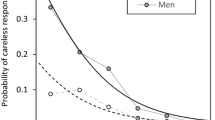Summary.
Objectives: To analyze the extent and relevance of a postulated “checklist misconception-effect” (a specific response pattern characterized by symptom-free persons not checking the “not at all”-category).
Methods: Our data is derived from a survey of blue collar workers (n = 228) who previously had filed in applications for medical rehabilitation benefits. We defined the “checklist misconception-effect” by the following response pattern: (1) at least one missing value and (2) at least one valid item response and (3) no ‘not at all’ responses.
Results: 75% of the responders had complete data, 16.2% a postulated ‘checklist misconception-effect’. Substantial covariations with socio-demographic characteristics or health status indicators could not be found. Additional imputation of missing values under the assumption of a “checklist misconception-effect” led to a reduction of missing data in the somatisation-subscale score from 12.3% to 0.4% compared to a simple manual-based calculation. Correlation with various external criteria (general health perception, level of functioning, depression) remained unchanged.
Conclusions: Ignoring the “checklist misconception-effect” would overestimate symptom load. However, the validity of this effect has still to be proven in methodological studies.
Zusammenfassung.
Fehlende Werte durch den ‘Listenfragen-Fehldeutungseffekt’
Fragestellung: Item non-response kann die Gültigkeit von Studienergebnissen erheblich beeinträchtigen. Am Beispiel der Subskala Somatisierung der SCL-90-R postulieren wir ein Antwortmuster (‘Listenfragen- Fehldeutungseffekt’), bei dem die Probanden bei Beschwerdefreiheit statt der vorgesehenen ‘überhaupt nicht’-Kategorie keine Antwort markieren. Die vorliegende Studie analysiert Ausmaß und Bedeutung dieses ‘Listenfragen-Fehldeutungseffekts’.
Methoden: Als Analysegrundlage dient eine postalische Befragung von n = 228 Versichterten einer Arbeiterrentenversicherung mit Antrag auf medizinische Rehabilitation. Der ‘Listenfragen- Fehldeutungseffekt’ wurde operationalisiert durch Antwortmuster (1) mit mindestens einem fehlenden Wert und (2) mindestens einem gültigen Wert und (3) Fehlen von ‘überhaupt nicht’-Antworten.
Ergebnisse: 75% der Befragten hatten komplette Daten, 16,2% einen postulierten ‘Listenfragen-Fehldeutungseffekt’. Substanzielle Kovariationen mit soziodemografischen Merkmalen und Gesundheitsindikatoren wurden nicht gefunden. Durch zusätzliche Imputation der fehlenden Werte unter der Annahme des ‘Listenfragen-Fehldeutungseffekts’ reduzierte sich der Anteil fehlender Skalenwerte im Vergleich zur einfachen Manual-gestützen Vorgehensweise von 12,3% auf 0,4%. Korrelationen mit verschiedenen Außenkriterien (Gesundheitszustand, Funktionsfähigkeit, Depressivität) blieben konstant.
Schlussfolgerungen: Die Nicht-Berücksichtigung des ‘Listenfragen-Fehldeutungseffekts’ führt zu einer überschätzung der Symptomausprägung. Die Gültigkeit des Effekts muss in weiteren methodischen Studien überprüft werden.
Résumé.
Non-réponses dues à une mauvaise conception du questionnaire
Objectifs: Analyser l’importance d’un “checklist misconception-effect” (type de réponses dans lequel le sujet sans symptômes ne coche pas de réponse au lieu de cocher la réponse «pas du tout»).
Méthodes: Les données sont tirées d’une enquête par questionnaire postal auprès d’assurés (n = 228) d’une caisse de retraite ayant présenté un dossier pour un traitement de réadaptation. Le type de réponse dont il a été tenu compte pour identifier le “checklist misconception-effect” a été défini comme présentant (1) au moins une réponse manquante, (2) au moins une réponse valable (3), et aucune réponse «pas du tout».
Résultats: 75% des personnes interrogées ont répondu à toutes les questions; chez 16,2% des personnes on a pu suspecter un “checklist misconception-effect”. Nous n’avons pas trouvé de covariations substantielles avec des aspects sociodémographiques ou des indicateurs de santé. Partant de l’hypothèse que ce “checklist misconception-effect” existe, les valeurs manquantes peuvent être remplacées et le nombre de réponses manquantes diminue par rapport au procédé conventionnel de 12,3% à 0,4%. Les corrélations avec divers critères (état de santé, vitalité, tendance dépressive) restent alors constantes.
Conclusions: En ne tenant pas compte de ce “checklist misconception-effect” on induit une surestimation de l’intensité des symptômes. La validité de cet effet reste à vérifier par d’autres études.
Similar content being viewed by others
Author information
Authors and Affiliations
Corresponding author
Rights and permissions
About this article
Cite this article
Meyer, T., Schäfer, I., Matthis, C. et al. Missing data due to a ‘checklist misconception-effect’. Soz.-Präventivmed. 51, 34–42 (2006). https://doi.org/10.1007/s00038-005-0005-9
Received:
Accepted:
Issue Date:
DOI: https://doi.org/10.1007/s00038-005-0005-9




